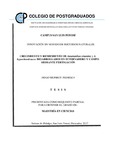| dc.description.abstract | Se realizaron dos experimentos de dinámica de crecimiento, eficiencia fisiológica y rendimiento de dos especies de amaranto (Amaranthus cruentus var. Frondosa y A. hypochondriacus var. Dorada) en condiciones de campo e invernadero, ambas bajo irrigación. En campo se evaluaron dos especies de amaranto (A. hypochondriacus y A. cruentus). El experimento se ubicó en Salinas, San Luis Potosí, durante el ciclo otoño-invierno 2015. Se utilizó un diseño experimental de bloques completamente al azar, con seis repeticiones. Con una densidad de 25 plantas m-2. Previo a siembra, se aplicó fertilización de fondo (órgano-mineral). Durante el desarrollo del cultivo, se fertigó con: 64N-37P2O5–71K2O. Se realizaron cinco muestreos destructivos para evaluar variables de: altura de planta (AP), longitud de panoja (LP), diámetro de tallo (DT), área foliar (AF), materia fresca (MF) y materia seca (MS) de acuerdo a su etapa fenológica. Posteriormente, se calcularon índices fisiológicos y morfológicos. A la cosecha se determinó rendimiento, acumulación de MS e índice de cosecha (IC). Así mismo se evaluó la eficiencia del uso del agua (EUA) de MF y grano. Frondosa tuvo mayor producción de grano con 2.3 t ha-1 e IC (0.18), con mejor EUA (7.1 kg mm-1) (P<0.05). Por su parte Dorada produjo mayor MF con 69.6 t ha-1 y más EUA (194.7 kg mm-1), pero tuvo menor IC y EUA en grano (0.12 y 4.35 kg mm-1, respectivamente) (P<0.05). En invernadero se evaluaron en el ciclo otoño-invierno 2015 dos especies de amaranto (A. hypochondriacus y A. cruentus), bajo tres tratamientos de irrigación (150, 200 y 250 ml planta día-1); con un arreglo factorial completo (3 X 2) y un diseño experimental de parcelas divididas en bloques completamente al azar con cuatro repeticiones. Las plántulas se establecieron en sustrato de fibra de coco y fueron regadas con soluciones nutritivas acorde a su fenología. Los nutrimentos y su concentración para los tres tratamientos de irrigación fue la misma. Se realizaron seis muestreos destructivos para determinar variables de: AP, LP, DT, AF, MS y MF de acuerdo a su etapa fenológica. Posteriormente, se calcularon índices fisiológicos y morfológicos. A la cosecha se determinó rendimiento, acumulación de MS e IC. Así mismo se evaluó la EUA de MF y grano. Frondosa tuvo mayor producción de grano con 3.7 t ha-1 e IC (0.18), con mejor EUA (11.5 kg mm-1) (P<0.05). Por su parte Dorada produjo mayor MF con 69.6 t ha-1 y más EUA (194.7 kg mm-1), pero tuvo menor IC y EUA en grano (0.15 y 9.3 kg mm-1, respectivamente) (P<0.05). A mayor volumen de agua hubo más producción en las dos especies de amaranto, teniendo con 250 ml planta día-1 valores de MF y EUA (151.7 t ha-1 y 469.8 kg mm-1); así como más rendimiento de grano (5.1 t ha-1), IC (0.17) y EUA (15.9 kg mm-1) con respecto a los tratamientos. _______________ GROWTH AND YIELD OF Amaranthus cruentus AND A. hypochondriacus GROWN UNDER GREENHOUSE AND FIELD CONDITIONS USING FERTIGATION. ABSTRACT: Two experiments were carried out under field and greenhouse conditions, both under irrigation, to know growth dynamics, physiological efficiency, and yield of two amaranth species (Amaranthus cruentus var. Frondosa and A. hypochondriacus var. Dorada). In the field, the experiment was located in the municipality of Salinas, San Luis Potosí, and was conducted during the autumn-winter 2015 cycle. A completely randomized blocks experimental design was used, with six repetitions, and a density of 25 plants m-2. Prior to sowing, an organic-mineral soil fertilization was applied; and during its development the crop was fertilized with: 64N-37P2O5-71K2O. Five destructive samplings were carried out to evaluate: plant height (AP), panicle length (LP), stem diameter (DT), leaf area (AF), and fresh (MF) and dry matter (DM), according to the phenological stage. Subsequently, physiological and morphological indices were calculated. At harvest, yield, DM accumulation and harvest index (CI) were determined. Likewise, the efficiency of water use (EUA) of MF and grain was evaluated. Frondosa had the higher grain production (2.3 t ha-1) and CI (0.18), as well as a better EUA (7.1 kg mm-1) (P <0.05). On the part, Dorada produced higher MF (with 69.6 t ha-1) and more EUA (194.7 kg mm-1), but had lower IC and EUA for grain (0.12 and 4.35 kg mm-1, respectively) (P <0.05). In the greenhouse experiment, both varieties of amaranth (Frondosa and Dorada) were evaluated in the autumn-winter 2015 cycle, under three irrigation treatments (150, 200 and 250 ml plant day-1); with a complete factorial arrangement (3 X 2), and an experimental design of divided plots into a completely randomized blocks, with four repetitions. Seedlings were established on coconut fiber substrate, and were watered with nutrient solutions, according to their phenology. Nutrient sources and their concentrations for the three irrigation treatments were the same. Six destructive samplings were carried out to determine: AP, LP, DT, AF, MS and MF, according to their phenological stage. Subsequently, some physiological and morphological indices were calculated. At harvest, yield, accumulation of DM and CI were determined. Likewise, the EUA for MF and grain were evaluated. Frondosa had higher grain production (3.7 t ha-1) and CI (0.18), with better EUA (11.5 kg mm-1) (P <0.05). On the other hand, Dorada produced higher MF with 69.6 t ha-1 and more EUA (194.7 kg mm-1), but had lower IC and EUA for grain (0.15 and 9.3 kg mm-1, respectively) (P <0.05). A higher volume of water had more production in both varieties, having with 250 ml plant day-1 values of MF and EUA (151.7 t ha-1 and 469.8 kg mm-1), as well as more grain yield (5.1 t ha -1), CI (0.17) and EUA (15.9 kg mm-1) with respect to the treatments. | es_MX |


